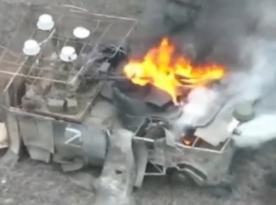Mainstream mass media have been misusing the word "strategic" in their coverage of the war between Ukraine and russia, inappropriately attributing small towns "strategic" importance and disregarding really important matters. Moreover, this trend seems to apply only one way: exaggerating russia's gains in Donbass and diminishing Ukraine's operations, argues Dr. Phillips O’Brien, professor of strategic studies at the University of St. Andrews and senior associate at Center for Strategic and International Studies (CSIS).
In his blog, O’Brien provides some examples of this trend in large media outlets and explains how the extreme over-use and misunderstanding of the word "strategic" creates an agenda that benefits (and was pushed by) russian propaganda.
Read more: Ukrainian Drones Finally Reached Moscow's Oil Refinery (Video)

The military analyst starts by defining what "strategic" actually means: "Strategic doesn't mean important or interesting or even well known, it means something of such importance that it materially changes the long-term planning and execution of the war. Something 'strategic' is of such importance that if one side takes it from the other, the affect will be so great as to change the course and dynamic of the whole conflict."
For example, Kyiv is strategic for being the largest city where the government resides as well as many defense industries. Another example is Kharkiv for being a major and historically important city. Anything that can shift the entire war if seized by either side. But many Western media outlets made "strategic" targets out of small towns in Eastern Ukraine, like Severodonetsk or more recently Pokrovsk where hardly any residents or industry have left due to intense hostilities.

While it might seem just mere word-fencing, this kind of labeling has an actual impact: russia is being widely portrayed as a steamroller capturing one strategic objective after another. However, whenever Ukraine makes successful moves, it's being neglected. In this context, the expert mentions the Ukrainian incursion in Kursk: while being approximately the size of entire russian gains in Donbas over the past two years, Western publishers rarely label anything in Kursk as "strategic."

What's more, they create the impression that "russia can basically take back the land Ukraine has occupied whenever it wants and Ukraine won't be able to liberate the land russia has taken," as exemplified by the headline to a recent New York Times article assuming that Putin's forces could "kick" Ukrainians out of russian territories whenever they decide to.

That's not to mention that Ukrainian forces have claimed more territory than the russians since summer 2022 — when the war dynamic shifted from its most active phase to a slow positional warfare grind.
It's not all about just the amount of captured land that is being neglected, though. Ukraine's regular strikes on the russian oil industry are what directly affect russia's ability to produce resources and keep the war machine going. However, this topic was widely covered with much less interest than another village taken by the russian troops.
For a reminder from Defense Express, just today, Ukrainian attack drones reached Moscow lighting the local oil refinery on fire, the one that satisfies around 40 to 50% of Moscow's needs in fuel and supplies aviation fuels to airports.

On a separate note, O’Brien highlights the fact that Ukraine has proven capable of launching substantial offensives like in Kursk while being severely restricted by its partners in the weapon systems it is given and how they can be used, referring first of all to the limits on the range at which the Ukrainian forces can use Storm Shadow and ATACMS missiles for strikes in russia. Whereas the russian army has never been limited in the variety or the allowed range of its weapons.
The full article by Dr. Phillips O’Brien can be found here.
Read more: Ukrainian Paratroopers Captured Seven russian Tanks in the Kursk Region (Video)














